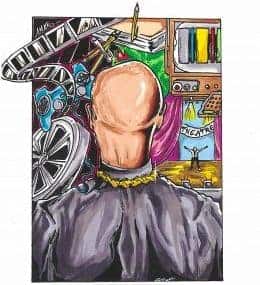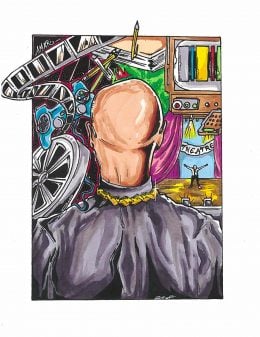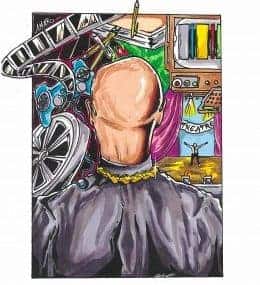Redefining Realness (My Path to Womanhood, Identity, Love & So Much More): Part 2/ Chapters 7 to Chapter 10 – Overview/ Review (with Spoilers)
Overview With her move back to Hawaii, you’d think things would have changed, but it seems this new start is really just a different location. Review (with Spoilers) The focus in this chapter is Mock’s return to Hawaii which seemingly, despite her returning to her mother, doesn’t seem all it is cracked up to be….

Spoiler Alert: This summary and review contains spoilers.
Additionally, some images and text may include affiliate links, meaning we may earn a commission or receive products if you make a purchase.
Overview
With her move back to Hawaii, you’d think things would have changed, but it seems this new start is really just a different location.
Review (with Spoilers)
The focus in this chapter is Mock’s return to Hawaii which seemingly, despite her returning to her mother, doesn’t seem all it is cracked up to be. Keisha has been buried in Texas, and now she is back to resuming her former identity in hopes that she can escape the self-loathing which came from not being masculine enough when she was with her dad. But, one thing that can be said is that at least her dad was consistently around.
Characters & Story
Mock is 12 years old in 1995, living in Hawaii. Her mother is her would-be guardian, but really her older sister Cori more so watches her than her mother or grandmother. But, being that Mock missed the closeness of her mother’s presence, even this sometimes there, sometimes not, availability of her mom is better than her former utter absence. However, it seems all the progress Mock made toward discovering her true self was regressed, if just because she didn’t want to give her mother one solid reason to push her away.
After all, even as loving as Mock’s dad was, her femininity always left a gorge between them. And being that Mock, has vocally expressed how much she loved having female role models up to this point, who better to emulate than your own mother? Even if you hide behind a mask of masculinity in order to hopefully please her?
But, even then, as Mock hides behind a self-made mask, she deals with her physical skin being an issue since she is both Black and Hawaiian, making her an outsider within her own home. Something which wasn’t a problem before when she was a child, nor a problem in California or Texas for, well everyone was Black and accepted her, to a point. So, with this chapter Mock discovers that while she may have better access to her mom, she can’t have her person as she may like, and also the issue of her ethnic background begins to come into play. Most of all, though, she slowly learns the benefits of masculine male privilege and though her mom doesn’t force her to act like a boy, the benefits from it are too good to pass up. After all, she sees being with her mom as being something more permanent and after all the teasing and issues she experienced with her dad, it can be assumed that this left a bit of a scar on her to the point where denying who she was seemed like an easier battle than dealing with other people who couldn’t accept her definitions, of which she has yet to really develop.
Chapter 8
Overview
It’s time to meet some girls like us.
Review (with Spoilers)
In this chapter, Janet speaks on the world before westernized ideology stepped in, where trans people like her not only had a place in society but also were kind of exalted. With this, she introduces not just her culture and story, as being trans, but also that of the place which allowed her to get comfortable with herself, one step at a time.
Characters & Story
At this point, Janet is butching it up, keeping her hair short, and doing her best to pass as a cisgendered, heteronormative, male. However, upon the introduction of Wendi, we learn that while Janet may have been trying hard, she wasn’t fooling her sisters. Thing is, though, Wendi “mahu” look. Now, to briefly explain what “mahu” is, basically it was, before western imperialism, represented those who were gender fluid in a way, though with the primary focus being on those who were born male but feminine. They were hula dancers, and instructors, spiritual healers, cultural bearers, and a slew of other things which have a good standing position in society. Mock even notes that other island cultures have similar specified, and positive, outlooks on those who were “mahu.”
Thing is, though, we are currently in 1996 and “mahu” has basically become a derogatory term at this point, which the local “mahu” were in the process of reclaiming to its former glory. But, back to Wendi, she spots Mock trying to be as boyish as possible and calls her out, publicly, which embarrasses the hell out of Mock so naturally, she denies any type of association. Thankfully, though, Wendi tries again, with a gentler approach, and through Mock’s friendship with Wendi, she learns to once again accept herself. For, as we saw, until her dad’s discovery of Keisha, Mock seemed pretty uninhibited when it came to her gender expression. Albeit, she did take note of how masculine Chad acted in comparison to how she did, but while it created a strong sense of needing a female role model, it didn’t stop her from being herself.
Of course, though, with fear that her father’s rejection of her would be worse with her already part-time show-up mom, she butched it up to not cause problems for herself and to give what she thought her mom would want. But with Wendi coming into her life, she got camaraderie and a sense of belonging which was further given to her upon meeting the adult mahus.
With their introduction though comes two main lessons: The first has Mock making sure you understand the difference between a drag queen and someone who is Trans, since the term transgendered she feels is an umbrella term. But, to keep it as simple as possible, Wesley Snipes in To Wong Foo and Wendi’s words “A drag queen is part-time for showtime, and a trans women is all the time” (Mock 113) pretty much give you an idea of the difference. As for the second lesson, it partly deals with Mock’s self-reflection. As noted earlier in the book, her journey is quite a lucky one. I mean, yes, there is Derrick, but what she wants us to note in this chapter is her friendship with Wendi, as well as Wendi’s life.
Wendi is out, proud, flamboyant and confidant. Someone luckily enough to have grandparents who would let them express themselves how they see fit, even if Mock explains her in such a way where she looks like something out of a 90s kids cartoon. But still, her and Mock had the privilege of growing up with each other. Something she notes isn’t available to a lot of trans teens who, again, haven’t been as blessed as Mock.
I mean, even Mock coming out as gay at 13 to her mom, this is taken like saying the sky is blue and there are no whippings, Mock getting kicked out, or nothing. Leading Mock to especially stress who lucky she was, for this was 1996. While RuPaul and drag queens were in movies, and even films like Paris is Burning, were out there, mind you there wasn’t the social networks we have today. So, those who were out were out, and those questioning or seeking information, well they were stuck between possibly revealing themselves, and hiding who they potentially maybe.
And even looking at modern times, Mock critiques the outlook given for girls like her. Yes, there are a lot of best case scenarios out there, and she is amongst one of them when it comes to the conversation, but it is usually white middle class people filling the conversation. Erasing QPoC and not really noting the difficulty of wanting to, and trying to transition as can be seen in Gun Hill Road.
Mock leaves us with her looking toward her future in Tracy, a woman who seemingly acted as one of Mock’s role models when it comes to trans identity. As well as the sisterhood of drag queens and trans women who bestowed the kind compliment of calling Mock a fish. Of which, as better explained by Corey in Paris is Burning, though we will use Mock’s words, “To be fish meant I could ‘pass’ as any other girl, specifically a cis woman” (Mock 115), and she continues on to speak about “Realness” and helps us understand the title of the book by saying,
“a trans woman or femme queen embodies ‘realness’ and femininity beyond performance by existing in the daylight, where she’s juxtaposed with society’s norms, expectations, and ideals of cis womanhood. To embody ‘realness,’ rather than performing and competing ‘realness,’ enables trans women to enter spaces with a lower risk of being rebutted or questioned, policed or attacked. ‘Realness’ is a pathway to survival” (Mock 116).
Making it seem her redefining realness, is very much about inclusion, more so than mimicry, and there being a space for girls like us amongst not just the conversation, but culture.
Things To Note
When I say “girls like us” I am referring to the tag used when Mock and Laverne Cox speak on their triumphs.
Chapter 9
Overview
As Janet fears the future, especially puberty, she comes to the realization of quite a few things.
Review (with Spoilers)
Though I do feel sometimes that each chapter seems like baby steps to get to the Mock we see on the cover, you have to realize sometimes that little moments are truly what make a person. Then, in the grand scheme of things, when you combine these little moments with the actions, or inactions, of those you consider major people in your life, it helps you understand why a chapter can seemingly have only a few key things, and yet be so important.
Characters & Story
With Wendi firmly placing herself within Janet’s life, she almost embodies a real life Keisha for Mock. Though, while Keisha was Mock’s version of her fully female form, Wendi is a bit more imperfect. For while Wendi seems fully comfortable with her personality and sass, she isn’t without insecurities. Her nose, for example, is one of her’s. But, with the story focusing on Mock, and her insecurities as a young trans person, the looming man in the shadows known as puberty comes to her mind.
And while hormones are brought up, at this moment Mock is just focusing on creating her sense of realness. One which, even with coming out to her mother, is slightly stifled. For one, she can’t get those long luxurious locks she wants so much, and while she attempts to express her girlhood whenever she can, including getting lip balm and getting tight clothing, she still very much is under an expectation of masculinity which she can’t shake.
Especially when Cori’s dad Rick comes back around. With his arrival, from prison, comes that old issue she had with her dad in some ways. But, being that Cori’s dad isn’t her’s, there is no reign to keep him from going too far. He bluntly calls Mock a faggot and questions how Mock’s mom raises her. Which, being that Mock has no problem rolling her eyes at a grown man, reminded her of something. During this moment, in which her Rick was throwing derogatory terms, no one said anything. Chad and Jeff are too young to really be expected to do anything, Cori is put in an off position between her dad and one of her favorite siblings, and then there is Janet’s mom.
In this moment, Janet is forced to take off those rose-colored glasses and remember that her mom is that person who for years abandoned her to be under some man. The woman who, as she later found out, was more so coerced to take note of her kids, than seemingly doing it out of her own will, much less guilt. And with this lack of defense, Mock’s tears end up clearing her vision of the woman she held highly. For while she maybe her mother, she is first, and foremost, some man’s lady. A position she seems far more proud of.
To make life worse, though, Rick gets into a fight with Cori’s boyfriend, leading her to live on her own, and with Rick not doing much but going to jail, this means Mock, her mom, and siblings have to move. Making Wendi a bit farther, but with the silver lining being they are moving to a better neighborhood. But with Mock finding some form of acceptance in her middle school, and now entering high school, she is forced to start all over, by herself, and we are left wondering whether, as the sweetly painted counselor Mr. Higa says, that because she is a good person, people will see that.
Chapter 10
Overview
In the end of part two, Mock is around 15 and has started taking pills to begin her transition.
Review (with Spoilers)
Time is beginning to fly as Mock starts high school and seemingly, with Wendi beginning her hormone treatments, Mock seems ready to be right alongside. However, even with this huge step in fully embracing her womanhood comes a shroud of secrecy. Her family knows nothing as Wendi shares the access she has been given, leading to Mock reminding us how fortunate parts of her journey were.
Characters & Story
With Mock separated from Wendi at school, but excelling, as usual, the awkwardness she expected seems to be all in her head. For with her doing so well in volleyball, she finds a stronger connection to her girlhood and begins dressing in what is more so comfortable for her than what maybe for the other students. But, as with most of her story, she finds herself, especially as time goes on, increasingly fortunate of not having to deal with bullies, death threats, or any of the matters which commonly are on the news when Trans teens are spoken on.
And with Wendi deciding she is ready to transition at 16, Mock finds herself using her access to Wendi to join her in transitioning. With this, Mock does a slight pause to educate us on the difficulties of transitioning, especially if you seek to have your insurance assist with the bill. She speaks on how you must be diagnosed with a mental illness, basically, and how otherwise a lot of which is required to transition will be considered “cosmetic.” Then of course comes the issue that learning about how to treat and prescribe stuff for Trans patients isn’t seemingly part of medical school, making a knowledgeable physician scarce and leading many Trans folk to rely on their communities. Of which, if they don’t have, can lead to self-medication which can be fatal.
Luckily, again, for Mock, Wendi pills aren’t from one of the ladies around the way, but an actual physician who seemingly didn’t put Wendi through psychological tests to get what she needed. But, when Wendi goes onto injections over pills, she lets Mock have her pills, by paying the co-pay for them, so she can transition with her sister. Leading to the burgeoning of Mock’s female form, sans one thing: The last remnant of her being seen as a boy.
Which could only lead me to believe that with the end of Part Two, Part Three may heavily deal with her transition and deal with more than her growing breast and a feminine figure, but perhaps what many cisgender folks question: What happened to the penis? Which, admittedly, I am curious about, but the journey is still far too compelling for that to be the perhaps highlight of the book. I’m still wondering how her love life was before Aaron since it feels like he isn’t even part of the conversation anymore and she is talking directly to us. Sometimes like a friend, other times like a teacher, though surely like a mentor to young Trans folk. But, increasingly as I read, I do feel glad she recognizes her privilege for outside her time with her father, especially the Derek situation, things seem rather smooth. Her mother is fairly accepting, if just because she is absent, Wendi introduced her to the Hawaii Trans community and gave her access to hormones, and pretty much the only thing absent right now is a love interest. Otherwise, she has acceptance, a moderately strong sense of self-confidence, and really, if I was to look at this from a young Trans teen’s point of view, her life, again sans when she was with her dad, almost seems like some middle class white kid who had everything you could want and dream of. Intelligence, a sense of realness, and supporters in various ways. Making me increasingly interested in Laverne Cox’s eventual book since she doesn’t paint her journey as so smooth.


